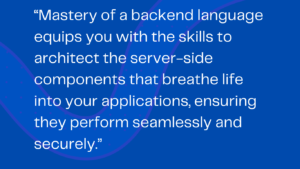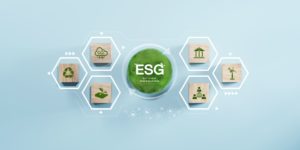Embarking on a career in software development is an exciting journey filled with opportunities for growth and innovation. However, the landscape of programming can be overwhelming, with countless languages, frameworks, and tools to choose from, each presenting its own set of challenges and possibilities. To help you navigate this vast terrain, we’ve put together a comprehensive software developer roadmap that outlines not only the fundamental milestones but also the essential resources that will empower you on your journey to mastery. So, fasten your seatbelt and prepare to embark on this thrilling adventure to become a successful software developer.
1. Master the Fundamentals
- Learn a Programming Language
Begin with a versatile language like Python, JavaScript, or Java, as they serve as the bedrock of modern software development. Python’s elegant syntax and extensive libraries make it a go-to choice for everything from web development to scientific computing. JavaScript, the cornerstone of web programming, enables you to breathe life into websites with dynamic interactivity. Java, a stalwart of enterprise applications, offers robustness and portability. These languages not only provide a strong foundation but also grant you access to vibrant communities and vast repositories of resources, ensuring that you’re never alone on your journey toward proficiency. With these tools in your arsenal, you’re poised to embark on a transformative learning experience.
- Understand Data Structures and Algorithms
These are the building blocks of software development, similar to the foundation upon which grand architectural marvels stand. Mastery of data structures and algorithms is more than just a skill set; it’s an arsenal of problem-solving techniques that will prove invaluable in tackling complex challenges with finesse and efficiency. Like a seasoned architect carefully selecting the right materials and engineering techniques, your proficiency in these fundamentals will enable you to craft elegant solutions that not only function seamlessly but also scale elegantly. Whether you’re optimizing algorithms for lightning-fast processing or architecting data structures for optimal storage, these skills form the cornerstone of your prowess as a software developer.
- Grasp Object-Oriented Programming (OOP) Concepts
Understanding OOP principles will help you design scalable and maintainable code, laying the foundation for robust and adaptable applications. By organizing code into reusable objects and classes, you’ll not only enhance the efficiency of your development process but also make it easier to collaborate with fellow programmers. Moreover, OOP fosters a modular approach, allowing you to update and expand functionalities with relative ease. This architectural discipline ensures that as your projects evolve, they remain agile and responsive to changing requirements, providing a solid framework for innovation and growth.
2. Explore Web Development
- HTML, CSS, and JavaScript
These three essential components work in harmony to craft the digital experiences we interact with daily. HTML, the backbone of the web, provides the structural framework, defining headings, paragraphs, links, and more. CSS steps in as the artistic brushstroke, breathing life into the content with visually pleasing layouts, colors, and styles. Meanwhile, JavaScript injects dynamism into the static, enabling interactive elements, form validations, and seamless user experiences. Together, they form the cornerstone of web development, empowering you to create engaging, responsive, and user-friendly websites that captivate audiences across the globe. As you delve deeper into these technologies, you’ll unlock the ability to transform ideas into tangible digital realities, ultimately leaving an indelible mark on the virtual landscape.
- Learn a Frontend Framework (e.g., React, Angular, or Vue)
Frameworks serve as the architectural blueprints that not only enhance your efficiency but also empower you to construct web applications that transcend the realm of static pages. They provide a scaffold of pre-built components and established patterns, enabling you to focus on the unique features and functionalities of your application. With frameworks like React, Angular, or Vue, you’ll wield the power to craft seamless user experiences, employ sophisticated state management, and effortlessly integrate with APIs and databases. Embracing these tools will not only streamline your development process but also open the door to a world of possibilities in creating immersive, user-centric web solutions. So, as you delve into the realm of frameworks, remember that you’re not just adopting a technology; you’re adopting a philosophy of efficient, forward-thinking web development.
- Understand Backend Development
Learn a backend language like Node.js, Python (Django/Flask), or Ruby (Ruby on Rails) to handle server-side logic and database interactions. These languages serve as the backbone of web applications, enabling you to create robust, efficient, and scalable server-side systems. Node.js, known for its event-driven architecture, excels in handling real-time applications. Python, with its elegant syntax and a wealth of libraries, offers versatility and ease of development, especially when paired with powerful frameworks like Django for rapid prototyping or Flask for lightweight applications. Meanwhile, Ruby on Rails, celebrated for its convention-over-configuration approach, empowers developers to build sophisticated web applications with remarkable speed and simplicity. Mastery of a backend language equips you with the skills to architect the server-side components that breathe life into your applications, ensuring they perform seamlessly and securely.
- Familiarize Yourself with Databases
Explore both SQL (e.g., PostgreSQL, MySQL) and NoSQL (e.g., MongoDB) databases to handle various data scenarios. Understanding SQL databases equips you with the power to design robust, structured systems, ensuring data integrity and seamless querying. On the other hand, delving into NoSQL databases opens up a world of flexibility, perfect for handling unstructured or rapidly evolving data. By mastering both, you’ll possess the versatility to architect solutions that cater to diverse business needs, from handling large-scale transactional data to building dynamic, real-time applications. This dual proficiency is the cornerstone of a well-rounded software developer, poised to tackle an array of data challenges with precision and ingenuity.
3. Dive into Version Control and Collaboration
- Git and GitHub
Version control is not just a tool; it’s a cornerstone of collaborative development. It allows you to track changes, revert to previous states, and seamlessly merge contributions from multiple developers. GitHub, in particular, transcends being a platform—it’s a bustling hub of innovation, where developers from every corner of the globe converge to share, critique, and refine code. Beyond its version control capabilities, GitHub’s collaborative features, such as pull requests and issue tracking, foster a culture of open collaboration. It’s here that ideas are refined, problems are solved, and groundbreaking solutions emerge from collective effort. Embracing version control and platforms like GitHub is not only a practical necessity but a gateway to a vibrant community of like-minded innovators.
4. Explore Software Development Tools
- Package Managers
Mastering package managers is related to equipping your toolbox with the finest instruments. These tools, such as npm for JavaScript, pip for Python, and Maven for Java, are the linchpin of efficient software development. They facilitate seamless integration of external libraries and dependencies, ensuring your projects are built on a foundation of robust, tried-and-tested code. With proficiency in these package managers, you’ll not only streamline your development process but also open the door to a vast ecosystem of resources and solutions that can significantly accelerate your projects. This invaluable skillset empowers you to wield the collective knowledge of the global developer community, giving you the capability to transform your visions into functional, elegant software solutions.
- Integrated Development Environments (IDEs)
Explore IDEs like Visual Studio Code, IntelliJ IDEA, or PyCharm to enhance your development experience. These integrated environments offer a suite of powerful features, including intelligent code completion, syntax highlighting, and robust debugging tools. They also support version control integration, making it seamless to collaborate with team members. Additionally, IDEs provide a customizable workspace, allowing you to tailor your environment to suit your unique workflow and preferences. Investing time in mastering these tools will significantly boost your productivity and efficiency in turning your code into functional, innovative software solutions.
5. Get Comfortable with Testing and Debugging
- Unit Testing
Learn how to write and execute unit tests to ensure your code functions as intended. This crucial step in the development process not only verifies the correctness of your code but also serves as a safety net, allowing you to make changes and enhancements with confidence. Embrace test-driven development (TDD) principles, where you write tests before writing the actual code, to foster a robust and reliable codebase. Explore testing libraries and frameworks like Jest for JavaScript, JUnit for Java, and PyTest for Python to streamline your testing process and bolster the reliability of your applications. Remember, a well-tested codebase is not just a mark of professionalism, but a key component in building software that stands the test of time.
- Debugging Techniques
Mastering the art of finding and fixing bugs efficiently is similar to becoming a skilled detective in the world of software development. It’s about honing your ability to dissect intricate code, identify elusive errors, and implement precise solutions. This process not only sharpens your technical acumen but also cultivates a mindset of relentless problem-solving. Moreover, it instills a profound sense of confidence, knowing that no bug, no matter how elusive, is beyond your expertise. As you delve into this essential aspect of development, you’ll discover that debugging is not merely a task, but an art form – an art form that separates proficient coders from true maestros. So, embrace this journey of unraveling the mysteries of code, for within every bug lies an opportunity to refine your craft and create software that stands the test of time.

6. Understand APIs and Web Services
- RESTful APIs
Learn how to design and consume APIs, a crucial skill for modern web development. Understanding the workings of API design empowers you to create efficient and scalable applications while being proficient in consuming APIs enables you to integrate seamlessly with third-party services and leverage their functionalities. This proficiency opens the door to a world of possibilities, from integrating social media platforms to harnessing powerful data services, all of which enrich the functionality and user experience of your applications. Embrace this skillset, and you’ll find yourself at the forefront of innovation, seamlessly connecting and extending the capabilities of your software in ways that were once unimaginable.
- GraphQL
GraphQL, a query language for APIs, has emerged as a game-changer in modern web development. Its power lies in its ability to allow clients to request precisely the data they need, no more and no less, providing a level of flexibility that REST often struggles to match. With GraphQL, you can streamline data fetching, reducing the over-fetching or under-fetching of information commonly associated with RESTful architectures. This not only leads to more efficient applications but also opens up new possibilities for real-time updates and data-driven experiences. As you delve into GraphQL, you’ll discover a paradigm that aligns data retrieval seamlessly with the needs of your application, paving the way for a more responsive and finely-tuned user experience. So, consider GraphQL not merely as an alternative to REST, but as a potent tool in your arsenal for crafting the next generation of dynamic, data-driven applications.
7. Explore Cloud Platforms and Deployment
- Cloud Services (e.g., AWS, Azure, Google Cloud)
Familiarize yourself with cloud platforms to deploy, scale, and manage your applications. Cloud computing has revolutionized the way software is developed, allowing for unparalleled flexibility and scalability. Platforms such as AWS, Azure, and Google Cloud offer a wide range of services, from virtual machines to serverless computing, enabling you to tailor your infrastructure to suit the specific needs of your applications. Understanding how to leverage these cloud resources effectively not only enhances the performance of your software but also ensures its resilience in the face of increasing demands.
- Containerization and Orchestration (e.g., Docker, Kubernetes)
Learn how to package your applications and manage them in a containerized environment, a practice that revolutionizes software deployment. Containers, like Docker, encapsulate your application along with its dependencies, ensuring consistent operation across various environments. Explore container orchestration with tools like Kubernetes, enabling you to scale, automate, and manage complex deployments effortlessly. This proficiency not only streamlines development workflows but also aligns you with industry best practices, positioning you as a developer poised for the challenges of modern software engineering.
8. Continuous Integration and Deployment (CI/CD)
- Tools like Jenkins, Travis CI, or GitHub Actions
Automate the process of testing and deploying your code, ensuring a smoother development workflow. By embracing Continuous Integration and Deployment (CI/CD) practices, you’ll not only streamline the integration of code changes but also accelerate the delivery of new features and enhancements. Tools like Jenkins, Travis CI, or GitHub Actions become your trusted crew members, orchestrating the entire pipeline from code commits to production deployment. This systematic approach not only minimizes human error but also fosters a culture of efficiency, allowing you to focus more on the creative aspects of development rather than the intricacies of deployment logistics. As the heartbeat of modern software development, CI/CD is an indispensable skill that will set you apart in the competitive world of tech.
9. Stay Updated and Engage with the Community
- Follow Industry Trends
Stay updated on the latest technologies, frameworks, and best practices, for they form the very heartbeat of the ever-evolving tech landscape. Embrace a mindset of continuous learning, immersing yourself in online communities, forums, and tech conferences. Engage in hackathons and coding challenges, where you’ll have the chance to put your skills to the test and collaborate with like-minded enthusiasts. Remember, adaptability is key; be open to exploring emerging technologies and methodologies, for they hold the potential to reshape the future of software development. By staying current and inquisitive, you’ll not only bolster your expertise but also position yourself as an invaluable asset in this dynamic field.
- Participate in Open Source Projects
Contributing to open-source projects not only provides invaluable hands-on experience but also fosters a sense of camaraderie within the global developer community. By collaborating on projects that are freely accessible and adaptable, you’re not only honing your skills but also playing a vital role in the collective advancement of technology. It’s a two-way street of learning and sharing, where you can benefit from the wisdom of seasoned developers while leaving your own mark on the open-source landscape.
Moreover, this collaborative spirit extends beyond technical expertise, teaching you how to work effectively in teams, communicate with diverse contributors, and tackle complex problems in a collaborative setting. This experience not only boosts your resume but also instills a deep sense of pride and accomplishment in knowing that your contributions are making a positive impact on the digital world. So, dive into the open-source community with enthusiasm, and watch as your skills and network flourish in this vibrant ecosystem.
Conclusion
Becoming a proficient software developer is a journey that involves continuous learning and hands-on practice. Remember, there is no one-size-fits-all approach, and it’s perfectly normal to iterate and adapt your roadmap as you progress, you can always refer back to this software developer roadmap anytime. Stay curious, be persistent, and enjoy the process of creating software that makes a difference.
As you navigate this exciting journey of software development, don’t forget about the vital support that can streamline your HR processes. Enter BorderlessHR: your dedicated partner in global HR management. With our innovative suite of tools and expert guidance, we simplify complex international HR tasks, ensuring compliance, efficiency, and peace of mind. Elevate your HR operations and focus on what truly matters – building exceptional software. Explore BorderlessHR today and unlock a world of HR solutions tailored to your unique needs. Your global success starts here.







